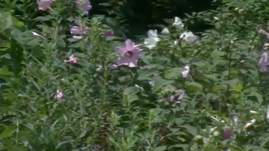Teachers' Domain - Digital Media for the Classroom and Professional Development
User: Preview


Funded in part by a grant from the U.S. Environmental Protection Agency under the Clean Water Act through the Kentucky Division of Water to the University of Louisville.
Special thanks to the Bernheim Forest and the Kentucky Division of Abandoned Mine Lands for their assistance.
This video shows how a rain garden at Bernheim Arboretum and Research Forest near Louisville, Kentucky slows down the flow of water from the forest’s parking lot and helps prevent soil erosion. Since soil erosion is one of the causes of non-point-source water pollution, rain gardens help protect the water supply. The video defines “site flow,” which is the movement of water across a site, and identifies several plants that thrive in the wet conditions of a rain garden.
This resource is part of the Water Solutions collection.
When you enter the Visitor Center at Bernheim Arboretum and Research Forest near Louisville, Kentucky, you’re immediately drawn to the building, which is surrounded by old growth trees and natural landscaping. The center is “friendly” to more than just the humans who visit the park daily. It is also environmentally friendly to the park’s forest, valley, wildlife, and watershed.
The center’s water-friendly features include:
To understand these features, it helps to identify a central environmental problem that the center’s designers were trying to alleviate. That problem is “non-point-source” or NPS water pollution. It is defined as “pollution discharged over a wide land area, not from one specific location. Nonpoint source pollution is contamination that occurs when rainwater, snowmelt, or irrigation washes off plowed fields, city streets, or suburban backyards.”
Part of the strategy behind the Visitor Center’s “green” design is to reduce NPS pollution by controlling and cleaning the water runoff from the site. But how do the building’s features make this goal possible?
First, let’s examine the green roof, basically a large planting box whose shallow soil and native plants filter and reduce the flow of rainwater runoff. Unchecked, this runoff would erode the soil around the building and become a source of NPS pollution. After leaving the “planting box,” rain flows through a root barrier to a special mat that diverts the water into a downspout system. This water then flows into one of two other “green features”: the ornamental pond reservoir used to water the surrounding landscaping and a cistern consisting of three 750-gallon tanks. The stored water from this cistern is used to flush the center’s toilets.
In many rural areas, human waste from toilets flows into streams through open pipes or is released into a septic tank/drainage field system. Either of these waste disposal methods can cause NPS pollution. At Bernheim this problem is resolved through the use of a peat filtration system that cleans wastewater. Peat moss within the tanks serves as a home for microscopic organisms that consume human waste and clean the water.
The water that leaves this system is used to irrigate the native plants in Bernheim’s greenhouses. Bernheim’s use of these native plants in restoration projects is another way of conserving water. Native plants require less watering because they are better suited to Kentucky’s climate than exotic or non-native species.
A rain garden is used to help control NPS pollution from the Visitor Center grounds. Located in a depression, the rain garden is a small wetland area where native plants such as silky dogwoods, papaws, sedges, and rushes naturally control and filter rain runoff.
Additional causes of NPS pollution are the oil and gasoline contaminants that leak from cars and other vehicles. To keep these pollutants from damaging the park’s watershed, Bernheim uses mycoremediation. At the lower end of the slanted parking lot, thick wood mulch covers the ground and provides a growing bed for oyster mushrooms (the prefix “myco” refers to fungi such as mushrooms). The mulch captures and absorbs water runoff from the parking lot, and the mushroom mycelia then go to work breaking down oil and gasoline contaminants (complex hydrocarbons) into less harmful molecules.
Not only do these features allow Bernheim Arboretum and Research Forest to prevent non-point-source pollution and conserve water, they also save the park money by reducing its reliance on municipal water supplies.
All the “green” features at Bernheim are a result of putting the scientific method into action. For instance, to answer the questions “What type of growing media works best on green roofs?” and “What native plants will thrive in this media?,” park staff members continue to research different plants and growing media using experimental roof grids. This kind of research makes the park even more environmentally friendly, serves as a tool for educating the public, and provides data for environmental studies worldwide.
 Loading Standards
Loading Standards